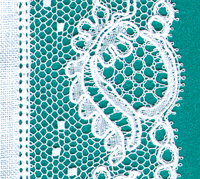
Tønder lace
Encyclopedia

Bobbin lace
Bobbin lace is a lace textile made by braiding and twisting lengths of thread, which are wound on bobbins to manage them. As the work progresses, the weaving is held in place with pins set in a lace pillow, the placement of the pins usually determined by a pattern or pricking pinned on the...
identified with the Tønder
Tønder
Tønder is a municipality in Region of Southern Denmark on the Jutland peninsula in south Denmark. The municipality covers an area of 1,278 km², and has a total population of 40,367...
region of Denmark since about 1850, although lace of many types has been made there since as early as 1650. The term is also used more broadly, to refer to any bobbin lace made in Denmark.
Tønder lace was traditionally made in fine linen
Linen
Linen is a textile made from the fibers of the flax plant, Linum usitatissimum. Linen is labor-intensive to manufacture, but when it is made into garments, it is valued for its exceptional coolness and freshness in hot weather....
thread, imported from the Netherlands
Netherlands
The Netherlands is a constituent country of the Kingdom of the Netherlands, located mainly in North-West Europe and with several islands in the Caribbean. Mainland Netherlands borders the North Sea to the north and west, Belgium to the south, and Germany to the east, and shares maritime borders...
. Since the disappearance of the very fine linen threads, it has commonly been made in cotton
Cotton
Cotton is a soft, fluffy staple fiber that grows in a boll, or protective capsule, around the seeds of cotton plants of the genus Gossypium. The fiber is almost pure cellulose. The botanical purpose of cotton fiber is to aid in seed dispersal....
. It is characterized by honeycomb fillings in motifs, square tallies in the ground, and the use of a gimp, a heavy thread outlining the cloth-stitch motifs. It often had large holes in the motif, called "Copenhagen holes", which were an attempt on the part of the lacemakers to speed up production of the lace, as they strove to compete with the cheaper machine-made lace. The designs used were similar to Mechlin lace
Mechlin lace
Mechlin lace is a bobbin lace originally produced in Mechelen. It is one of the best known Flemish laces. It is fine, transparent, and looks best when worn over another color. It was made in Mecheln, Antwerp, Lier and Turnhout...
, with lots of flowers.
History
Tønder lace was mainly made during the late 18th and early 19th centuries. Production started in 1647 when a merchant brought lacemakers from WestphaliaWestphalia
Westphalia is a region in Germany, centred on the cities of Arnsberg, Bielefeld, Dortmund, Minden and Münster.Westphalia is roughly the region between the rivers Rhine and Weser, located north and south of the Ruhr River. No exact definition of borders can be given, because the name "Westphalia"...
to Tønder to teach lacemaking to the general population. Christian IV protected the manufacture of local lace, and didn't wear any foreign lace. In 1712 several lacemakers from Brabant
Duchy of Brabant
The Duchy of Brabant was a historical region in the Low Countries. Its territory consisted essentially of the three modern-day Belgian provinces of Flemish Brabant, Walloon Brabant and Antwerp, the Brussels-Capital Region and most of the present-day Dutch province of North Brabant.The Flag of...
accompanied the troops of King Frederick IV
Frederick IV of Denmark
Frederick IV was the king of Denmark and Norway from 1699 until his death. Frederick was the son of King Christian V of Denmark and Norway and Charlotte Amalie of Hesse-Kassel .-Foreign affairs:...
on their return from the Netherlands, bringing new techniques. Tønder lace was a major industry, and most of the region's girls were employed in making it. Little boys, before they were strong enough to work in the fields, were also taught to make lace. In 1801 20,000 people in Tønder and the immediately surrounding area were employed making lace. When machine-made lace was introduced in the late 1800s, the handmade lace industry gradually ceased to be economically important to the region. It never died out entirely though, and is still made today, mostly by hobbyists.

